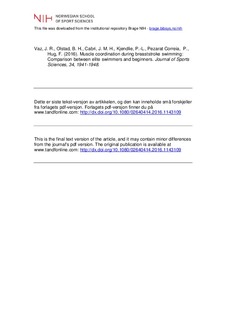| dc.contributor.author | Vaz, João R. | |
| dc.contributor.author | Olstad, Bjørn Harald | |
| dc.contributor.author | Cabri, Jan | |
| dc.contributor.author | Kjendlie, Per-Ludvik | |
| dc.contributor.author | Pezarat-Correia, Pedro | |
| dc.contributor.author | Hug, Francois | |
| dc.date.accessioned | 2017-09-04T08:07:36Z | |
| dc.date.available | 2017-09-04T08:07:36Z | |
| dc.date.issued | 2016-02 | |
| dc.identifier.citation | Journal of Sports Sciences. 2016, 34, 1941-1948 | nb_NO |
| dc.identifier.uri | http://hdl.handle.net/11250/2452912 | |
| dc.description | I Brage finner du siste tekst-versjon av artikkelen, og den kan inneholde ubetydelige forskjeller fra forlagets pdf-versjon. Forlagets pdf-versjon finner du på www.tandfonline.com / In Brage you'll find the final text version of the article, and it may contain insignificant differences from the journal's pdf version. The definitive version is available at www.tandfonline.com | nb_NO |
| dc.description.abstract | The present study aimed to compare muscle coordination strategies of the upper and lower limb muscles between beginners and elite breaststroke swimmers. Surface electromyography (EMG) of eight muscles was recorded in 16 swimmers (8 elite, 8 beginners) during a 25 m swimming breaststroke at 100% of maximal effort. A decomposition algorithm was used to identify the muscle synergies that represent the temporal and spatial organisation of muscle coordination. Between-groups indices of similarity and lag times were calculated. Individual muscle patterns were moderately to highly similar between groups (between-group indices range: 0.61 to 0.84). Significant differences were found in terms of lag time for pectoralis major (P < 0.05), biceps brachii, rectus femoris and tibialis anterior (P < 0.01), indicating an earlier activation for these muscles in beginners compared to elites (range: −13.2 to −3.8% of the swimming cycle). Three muscle synergies were identified for both beginners and elites. Although their composition was similar between populations, the third synergy exhibited a high within-group variability. Moderate to high indices of similarity were found for the shape of synergy activation coefficients (range: 0.63 to 0.88) but there was a significant backward shift (−8.4% of the swimming cycle) in synergy #2 for beginners compared to elites. This time shift suggested differences in the global arm-to-leg coordination. These results indicate that the synergistic organisation of muscle coordination during breaststroke swimming is not profoundly affected by expertise. However, specific timing adjustments were observed between lower and upper limbs. | nb_NO |
| dc.language.iso | eng | nb_NO |
| dc.publisher | Taylor & Francis | nb_NO |
| dc.subject | swimming | nb_NO |
| dc.subject | muscle synergies | nb_NO |
| dc.subject | electromyography | nb_NO |
| dc.subject | expertise | nb_NO |
| dc.subject | coordination | nb_NO |
| dc.title | Muscle coordination during breaststroke swimming: comparison between elite swimmers and beginners | nb_NO |
| dc.type | Journal article | nb_NO |
| dc.type | Peer reviewed | nb_NO |
| dc.source.journal | Journal of Sports Sciences | nb_NO |
| dc.identifier.doi | 10.1080/02640414.2016.1143109 | |
| dc.description.localcode | Seksjon for fysisk prestasjonsevne / Department of Physical Performance | nb_NO |
